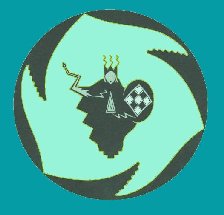
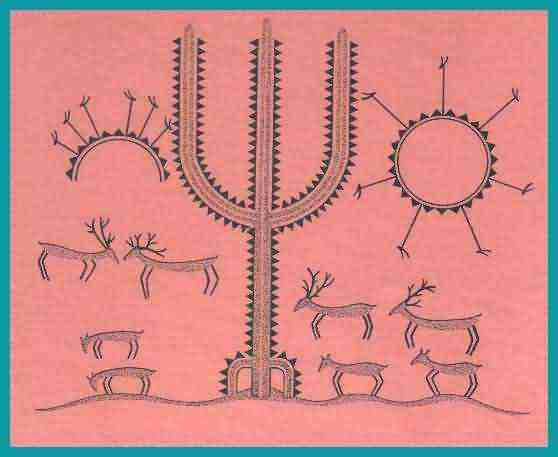
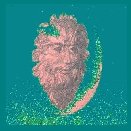
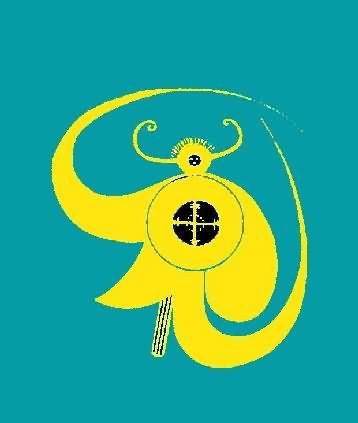
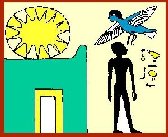
(13) The Universal Tree and the Shamanic Journey
One of the most penetrating shamanic cosmologies is that of the Selkup or forest people in Siberia somewhat north of Tomsk, and one of its primal concepts is that of the Great Tree of All Life shown on the cover of this book. The side governed by the half-circle depicting the lunar crescent is the Lunar Root and Branch. It is on the left as one views the Tree, and to the right if one stands in it. The Solar Branch and Root (on the heart- or left-side of the Tree if one stands in it) is ruled by the full circle symbolic of the solar disk. The differentiated life-forces of the two sides join in the central trunk, and specifically at the growing point of the topmost spire. That central union expresses the nature of the dynamically complete self.
But the Tree is also the entire life scheme that runs throughout and joins all living things, and there is nothing that on some level is not alive. The shaman/ess can thus ride the life currents of the Tree to reach the life centre of any creature. The life currents of the Great Tree are likened to a magical steed on which the shaman/ess is borne throughout the seen and unseen cosmos.
Let us step back a moment to compare these ideas with the old Nordic shamanic teaching of the cosmic ash tree Yggdrasil, so deeply connected to Odin, the Norse shamanic deity par excellence. It has three great roots. The first reaches down to the realm of departed souls in Nifheim, "the beclouded place" (see also Bardo in Glossary). This is the Lunar Root, on your left hand as you view the Selkup drawing, but on your right if you become one with and enter the Tree.
The second or central Root stretches down to what in the Norse tradition is the three sister-Weirds: Urd (necessity, past); Verdandi (the German werdend = becoming, i.e, the present) and Skuld (fate, future).
The third, the Solar Root, is on the right as you behold it but on the left when you enter the Tree. It reaches deep into the Well of Mimir that dispenses all-encompassing memory and wisdom. To drink of this unforgettable water Odin hung on the tree nine nights: "An offering to Odin, of myself to my Self", he sang. Here Odin (still meaning the first, the number 1, in Russian) is the primal shaman. Thus recalling what you were (and really are), you can act differently in the present and so change and re-shape the still malleable future. This is what Odin taught.
All shamanic experience means entering the Tree and thus reaching any desired entity throughout the entire life wave, whether presently in molecular incarnation or not. This means "riding" the Tree, and that Odin did by means of his eight-legged magical horse. Indeed, in the same nordic version of this universal shamanic mythos the name of the Tree is Yggdrasil, which is literally "Odin's Horse"; and the name of the horse is Sleipnir ("slippery one"), the current Norwegian cognate of sleip being slip, the word for the slippery liquid film on fishes. The Sleipnir is the living sap that courses through the Tree of all Life. The eight legs, head, and tail constitute a paradigm expressing the whole Tree with head (crown) and branches (forelegs) at one end, and the equally branching root system at the other end are the wind-blown tail and hind legs. The "wind" here is the living force of the whole life breath.
The initiated shaman/ess must learn how to ride this wonderful horse (that appeared later in corrupted form as the medieval witch's broomstick, the broom being the tail) on which she rode through skies of Odin's Wild Hunt. Through the horse/tree, one first descends into the roots and then up through particular and myriad pathways to even the tiniest branch and leaf where the being needing help is livingly attached to the Tree. After accomplishing the theurgic work one returns - through the Tree again - to where one was at the journey's start, now also its end, thus making the circle complete.
The way you enter the Tree and "ride" through it is not found in three-dimensional space, but in a higher dimensional direction as noted in the little anecdote in Part I. Imagine a two-dimensional being: one able to move only in two dimensions. For instance, on the surface of a vast sheet of paper only two mutually perpendicular lines can be drawn through any given point on that surface. Imagine, then, on that sheet that two-dimensional being now enclosed by a circular "wall" around her, and that you lifted her and placed her back again on the sheet but outside the wall. She could then well ask, but how did you transport me here? For you did not pass through the wall and hence did not take me out along any of the infinity of directions that radiated outward from me to the surrounding circular wall!
Your reply would be simple, but almost incomprehensible to her as you say: "No, you are quite right. I did not use any one of that infinity of paths, for that would have meant injuring you by collision with the inside of the wall as you tried to pass beyond it to outside of it as you are now. So all I did was to direct you along a higher dimensional direction (that is, in three-dimensional space, which to her would be "higher") which is perpendicular to all those countless directions. Thus none of them was used because you took an extra-dimensional leap out of and back into your world. Our 2D lady, being a trained mathematician in her world, would understand what you said in principle, would know it was provably correct, and yet would not be able to imagine or visualize it in the least.
So is it with our world and getting into the Tree by a path that is not any of the infinity of directions possible in three-dimensional space. Traveling such distances is perfectly possible, and if you fall back through such a distance into your molecular body, you will feel a shock similar to what your body would feel through a fall through a distance here. There are ways you can learn how to quiet your consciousness, your spinning mind-wheel of associations, memories and sensory inputs - a skill sometimes called knowing how to meditate, although no word does justice to what actually occurs (see Section 26 for some details). Those of you who have tried them would know that the Lion Path cassettes are an easy way to get to be able to do that. You will then also realize that if, say, you were suddenly shaken out of your altered and quieted state by some sudden shock, "falling" back into the molecular body would be experienced very similarly to a sharp short fall in our ordinary three-dimensional world. This is also an experiential way to know that we really move in some sense when we enter, travel in, and return from the Tree in shamanic work. There is of course no need to visualize all this. The metaphor will translate itself into its own reality. An easy time to prepare to take such journeys is on any Wednesday after August 4, 1999, or on one of the dates of "manual override" already given. Shamanic journeying is often felt to be so much like flying that its prime symbol is a strong bird as, for instance, the eagle among the Selkup and the Falcon (and kite) among the shamanic priest (esses) in Ancient Egypt. Here is the experiential origin of creatures like Pegasus, the winged horse, or the Taoist tales of being carried on the winds of a magical crane in flight or on the back of the mighty Simurgh of the lore of the Magi, shamans of old Iran - recalling the flying Dragon ("loong") of ancient China.
The link between the Tree of All Life and the human psyche is made clear in one of the ancient pre-Buddhist shamanic teachings that are preserved, often uniquely, in Buddhist texts. For instance, in the Uighur (an old Turco-Mongolian tongue) manuscript version of the Bardo T'hos-grol, which concerns the technique and vicissitudes of dying. Folios 20 verso to 21 recto of the Uighur text testify to a clearly shamanic tradition: "Some pundits express the view that the tamir-network taken all together looks like the sacred larch tree …" Tamir is the Uighur cognate of the Sanskrit nadi (Tibetan rTsa) that denotes one of the channels or helically formed tubules of the supraphysical wave-guiding energy that underlies all the biochemical/molecular energetics, transformations and operations of an organism, and which is amply developed in the human body, keeping in pace with a complex neuronal network.
The Lam-rim of Tsong-khapa, drawing on rNying-ma teachings, also echoes the ancient shamanic image of the inner network of branching channels as a microcosmic counterpart of the macrocosmic sacred larch tree. He reiterates the connection between the Great Tree's three main roots (left or solar, and right or lunar) with the three great chakras or radiative centres of supra-physiology: the heart, throat and crown centres. These chakras correspond to the threefold forms of the higher or diamond body (vajrakaya): the dharmakaya or body of fundamental reality, the nirmanakaya or shape-shifting body that can conform to any appropriate appearance, and the sambhogakaya or body of lasting joy.
The three roots of the Tree also respectively correspond with the principal nadis that were mentioned before. But the closely shamanically linked Tibetan tradition preserved the right assignments better than the erroneous (reversed) associations of the red pingala or lalana with the right side and the white ida or rasana with the left. The Tibetan tradition, going back to earlier Sanskrit yoga texts, correctly assigns rKyang-ma the red (solar) channel to the left side of the body, and ro-ma the white (lunar) channel to the right side. There is no ambiguity with the central channel: dBuma in Tibetan, and sushumna or avadhuti in Sanskrit.
Thus the Tree is vast in meaning. As that expert and too little known calligrapher, poetess, and exquisite translator of Chinese poetry, Helen Burwell Chapin, so perceptively wrote in her Round of the Year :
"The roots of the Tree of Life extend beyond time."
Next Chapter